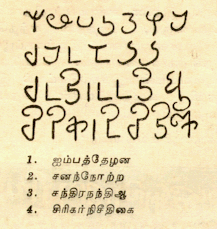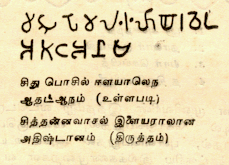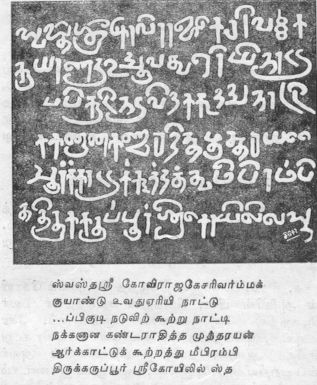
While the earliest extant Tamil inscriptions, whether written in Asokan Brahmi, or in the local Tamil script, are set in the early centuries of the Christian era,scholars have perforce to look for additional evidence for details of earlier forms of Tamil writing only in the earlier extant Tamil literature. The earliestextant work is the Tolkappiam, the celebrated work of Tamil Grammar, often considered the Tamil counter-part of Panini's work on Sanskrit Grammar, and considered by tradition to originate in the Sangam period of the centuries prior to the start of the Christian era.
The Tolkappiam (according to the commentator, Ilampuranar) is comprised 1595 Verses spread over three Books, each in turn, containing nine Chapters. Their comprehensive content dealing with every aspect of the structure and usage of the language does quite certainly point to the language having evolved to a high degree of sophistication over several prior centuries, or perhaps millenia. The work commences with a very detailed account of the letters of the alphabet, the way their sounds originated from the throat, and the rulesand sequences in which the letters were joined to form words. The first Chapter of the First Book of the Tolkappiam is significantly entitled " öÇêÐÊ " , which refers to letters of the alphanbet, and which would normally imply both their spoken and written forms. The very first verse of this Chapter runs thus :
öÇêÐâêäçªçÌç
íæõËêùª
äæõ ¬×ôèáª
Ëçªç þ âêäªç
òèõÐåÐÊôõùª
ëõç¨äª ßäª÷觪
æìîô
Translated, the verse
reads : " The letters are said to be from 'a' to 'n' (
í
to ä
), thirty in number, excluding three whose use are dependent on the others"
The Tolkappiam itself has an explicit reference to writing in Book - 2, Chapter -1, Verse -60, where it refers to the inscription on commemorative stones of the name and valour of warriors who distinguished themselves in battle. This unique Tamil tradition persisted for long and such stones dated to later centuries have indeed been found. But we are yet to get direct cliching physical evidence, not resting on indirect surmise or inference, of how the writing actually looked at the time the Tolkappiam was composed.
The earliest extant written
forms of Tamil are in the Brahmi script or in a local
Tamil scriptin a form called the
va÷te¸uttu (
ôìªâìÇêÐÊ
, meaning rounded writing)Two other
names for the Tamil script found in the earliest extant Tamil literature
are kaõõe¸uttu (
æúªâúÇêÐÊ,
also suggestive of the rounded shape, and
referred to in the Silappadikaram) and
kÌle¸uttu (
îæèâùÇêÐÊ
, suggestiveof use of a stylus, and referred
to in the Kural). In a Tamil article entitled
"Tamil Stone Inscriptions", in the Silver Jubilee Souvenir of the Delhi
TamilSangam, Professor C.Govindarajan
provides the following two illustrations to show
how the Tamil va÷te¸uttu
( ôìªâìÇêÐÊ
) was quite different from the Tamil Brahmi, and also suggest that it was
indeed the authentic written form of ancient Tamil.


